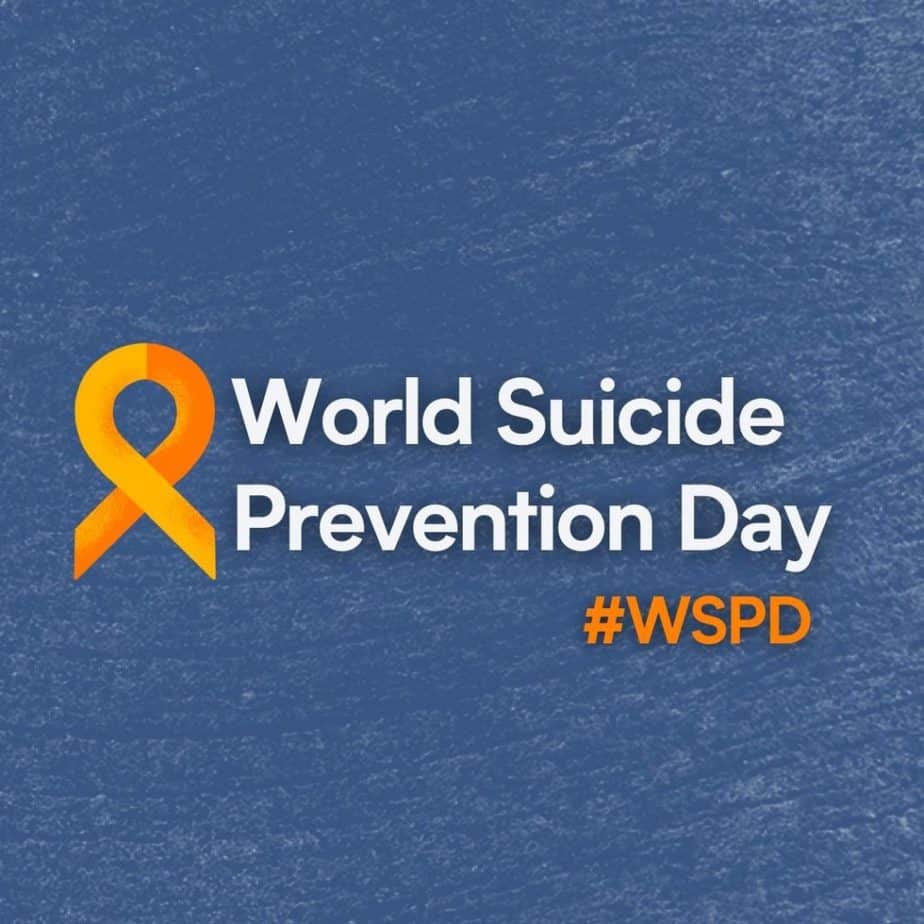Creating Hope Through Action
Every 40 seconds, someone loses their life to suicide, according to the World Health Organization. [1] World Suicide Prevention Day aims to educate people on the signs and behavior correlated with suicide and provides information and resources to encourage prevention. The theme this year is “Creating Hope Through Action”

‘This will be the day for all those people who have suffered because the worst of the human tragedies happened too close to them. This will be the day for governments to know that suicide must be a priority in their public health agenda. This will be the day for all people on the earth to recognize that suicide is an important problem, and if the World Health Organization has decided to endorse this celebration it must mean that its dimension is huge, and that no one is immune from it. But this will also be the day for us, IASP members, who have dedicated and are dedicating our lives to avert suicide, and who, at the very least, have contributed to raise awareness, worldwide, on the size and stigma of this immense suffering’.
– International Associate for Suicide Prevention
Preventing Suicide: A Global Imperative
77% of global suicides happen in low- and middle-income countries. [3] Ingestion of pesticides, hanging, and firearms are among the most typical means of suicide globally.
Suicide was the second most significant cause of death among young individuals aged 15 to 29 years, behind traffic accidents. The second most important cause of mortality for women was suicide (after maternal conditions) and the third most important cause of death in boys aged 15 to 19 years (after road injury and interpersonal violence). [4]
The emotional impact can remain for many years for family and friends affected by suicide or attempted suicide.
Major Risk Factors For Suicide
While the connection between suicide and mental disorders (in particular, depression and alcohol abuse) is well set in high-income countries; many suicides occur impulsively in times of crisis with a breakdown in the capacity to deal with life stresses, such as financial problems, relationship break-up or chronic pain and illness.
In addition, undergoing conflict, disaster, violence, abuse, or loss and a sense of isolation are strongly correlated with suicidal behavior. Among the vulnerable, such as refugees and migrants, indigenous peoples; lesbians, gays, bisexuals, transgender, intersex individuals (LGBTQI), and convicts, the rates of suicide are also high. However, by far, the most potent risk factor for suicide is a previous suicide attempt.

More than 703,000 people die by suicide each year. [2] Furthermore, there are more than 20 suicide attempts for each suicide. Suicides and suicide attempts to have a cascading impact on families, friends, coworkers, communities, and societies. Suicides, on the other hand, are avoidable. Suicide prevention may be successful at the individual, community, and national levels.
Warning Signs For Suicide
- Verbalizing thoughts or feelings about wanting to end their life, or talking about feeling hopeless or having no reason to live
- Expressing feelings of loneliness, withdrawal from others or social isolation, being a burden to others, or being in unendurable pain
- Unrest, violence, distress, or difficulty in interacting
- A change in eating or sleeping habits
- Signs of cutting or self-harm
- Arranging end-of-life personal affairs, such as writing a will; and absence of supportive family members or other psychosocial support
Consider And Assess The Risk Factors For Suicide
These may also include:
- Previous suicide attempts
- Depression
- Alcohol or drug use problems
- Other mental health conditions such as psychosis or bipolar disorder
- Severe emotional distress
- Chronic pain or illness
- Events of trauma (e.g., sexual, and interpersonal violence, war, abuse, discrimination)
- Recent loss (e.g., unemployment, bereavement, relationship break-up)
- Financial problems
World Suicide Prevention Day Awareness and COVID-19
The COVID-19 Pandemic has added to increased feelings of isolation and vulnerability to many individuals.
Any danger to the stability of the mind of a person may increase suicide risk factors. A dramatic change in lifestyle and stresses such as those of COVID-19 may lead to suicidal ideas and conduct. The National Biotechnology Center reports that suicide mortality in the United States rose during the influenza pandemic 1918–19 and the severe acute respiratory syndrome (SARS) outbreak in 2003 for elderly persons in Hong Kong. There are many statistics. There are increasingly severe detrimental consequences of the present pandemic on general mental health; including deterioration of existing issues such as contagion fear, anxiety, social isolation, and chronic stress.
There is also an increased suicide risk for individuals and their families who have incurred COVID-19 due to felt stigma. [5]
So, if you are concerned about yourself or someone in your family or community, reach out to them and ask, “Are you okay?” Checking in and offering broad-minded care can make a difference!
Preventing Suicide
According to International Association for Suicide Prevention [6], there are five reminders for us on how to prevent suicide:
- ‘Creating Hope Through Action’: A reminder that our actions, no matter how big or small, may provide hope to those who are struggling.
- Suicidal thoughts are complex: The circumstances and causes that lead to suicide are complicated, and no single approach works for everyone. We know that certain aspects and life experiences may make someone more susceptible to suicide and can also lead to mental health problems such as anxiety and despair.
- You can help give someone hope by showing that you care: We may never know what we do that makes a difference. We all can reach in and ask someone. You do not need to tell them what to do or have solutions, but simply making the time and space to listen to someone about their experiences of suffering or suicidal thoughts can help.
- The insights and stories of people with a lived experience of suicide: It can be compelling in helping others understand suicide better and encourage people to support someone and reach out for help themselves. In this case, the person sharing their story must know how to do it safely; and for those who hear their story.
- Individuals sharing experiences of being bereaved through suicide and how they came to live their ‘new regular can help others experiencing suicidal loss make sense of the devastation of suicide and believe they will live through and with the loss. Sometimes, when somebody dies by suicide, their surviving family and friends may encounter shock; anger, guilt, symptoms of depression or anxiety, and may even share suicidal ideations themselves.

What You Can Do
Steps On How To Approach Someone Struggling With Suicidal Ideation
- Allot sufficient time to talk to the person in a private space, show empathy, and establish a positive rapport
- Lead into the issue gradually, measure the person’s current mental state before asking straight if they have thoughts about suicide. Asking about suicide does not motivate suicide but can lessen anxiety and helps the person feel understood.
- If the person confirms that they have thought of or are thinking about suicide, ask follow-up questions to determine whether they have made firm plans.
If The Person Has Suicidal Ideations, But The Goal Is Not Concrete Or Immediate
- Offer emotional support, inspire them to talk about their suicidal feelings, remind them of their strengths; encourage them to talk of how they fixed problems in the past, and explore reasons and ways to stay alive.
- Give them with details of a mental health specialist if possible, and keep regular contact, initially by making another appointment; and
- Activate psychosocial support by reaching out to family or friends and community resources, and give details of community services, including crisis lines.
- If the person has a solid plan, including the means and the intention to die, stay with the person, remove the means of suicide. Ask a mental health specialist and designate a family or staff member to stay with the person so that they are not alone until further specialist support is in place.
- After a suicide attempt, make sure the person knows available community services to provide support and a plan for regular and well-coordinated follow-up contact. Explain to the person and their family the advantages of staying in connection with health services.
Addiction Facts For World Suicide Prevention Day
The connection of alcohol and drugs with suicidal ideation and behavior is both causal and conductive. The subjective state of hopelessness is key to the disposition to suicide. Alcohol and drugs are instrumental in providing a feeling of hopelessness by their toxic effects, probable manipulating neurotransmitters accountable for mood and judgment, and disturbance of interpersonal relationships and social support.
The classification of alcohol and drug use and dependency is critical to the proper assessment of suicide. According to studies, over fifty percent of all suicides have a connection with alcohol and drug dependence, and at least 25% of alcoholics and drug users commit suicide. Moreover, over 70% of adolescent suicides may have complications with drug and alcohol use and dependency. Because alcoholism and drug addiction are leading risk factors for suicidal behavior and suicide ideation, any alcoholic or drug user should be evaluated for suicide, mainly if actively using alcohol or drugs. [8]
Alcohol and substance abuse problems contribute to suicidal behavior in several ways. Persons who are also dependent on substances often have several other risk factors for suicide. In addition to having depression, they are also likely to have social and financial struggles. Substance use and abuse can be shared among persons prone to be impulsive and among persons who join in many types of high-risk behaviors that result in self-harm. The good thing now is, several practical prevention efforts lessen the risk for substance abuse in youth, and there are also effective treatments for alcoholism and substance abuse.
World Suicide Prevention Day Is A Reminder To Ask For Help
Stigma, especially surrounding mental disorders and suicide means many people considering taking their own life or who have attempted suicide are not asking for help. The prevention of suicide has not been sufficiently addressed due to a lack of awareness of suicide as a significant public health dilemma and the taboo in many societies to discuss it openly. Raising community awareness and breaking down the taboo is crucial for countries to make advancements in preventing suicide.
As we observe World Suicide Prevention Day, we hope that together we can end the stigma caused by suicide and begin to address this condition to lessen the mortality rate and help our loved ones to save their lives.
About We Level Up Treatment Centers
We Level Up is a renowned treatment center that applies evidence-based treatment modalities and holistic programs to improve client recovery outcomes—combining traditional elements of SUD treatment, including supervised medical recovery coupled with intensive behavioral rehab.
Offering cutting-edge advanced therapies, We Level Up is an accredited dual diagnosis mental health care provider. Fully integrating co-occurring conditions into our programs. Most importantly, our top-notch doctors, therapists, and specialists leverage the power of science to help clients succeed in rehab recovery.
We provide best-in-class treatment in multiple locations, with amenities and activities designed to reinforce recovery success metrics. In addition, each client receives lifetime alumni support post inpatient treatment along with family resources to help maintain recovery momentum, even once they depart our treatment facilities.
Above all, our vision is to help create legions of self-empowered individuals who are entirely in control of their lives and destinies, enabling them to get what they desire from this life, experiencing it to their fullest, most liberating potential. Through these hosts of self-empowered and self-aware individuals, we will see families that communicate with more love, trust, and caring for one another, businesses that thrive in ways never before thought possible, and friendships that reach new heights.

If you consider addiction treatment for you or someone you love, We Level Up can help. Please contact us today for a confidential consultation with a member of our intake team and more information regarding World Suicide Prevention Day.
Sources:
[1] World Suicide Prevention Day 2019 – 40 seconds of action – World Health Organization
[2] Suicide Prevention – World Health Organization
[3] Suicide – World Health Organization
[4,7] One person dies every 40 seconds – World Health Organization
[5] World Suicide Prevention Day – National Institute of Health
[6] WORLD SUICIDE PREVENTION DAY 2021 – International Association for Suicide Prevention
[8] Suicide risk associated with drug and alcohol dependence – PubMed.gov National Library of Medicine